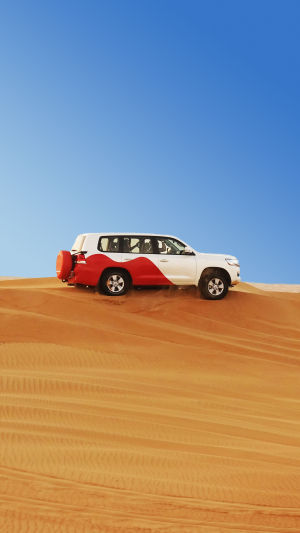Driving an off-road vehicle in the desert is the dream of many off-road enthusiasts. The vast expanse of yellow sand brings a sense of boundless freedom, allowing riders to gallop to their hearts' content.
Every grain of sand in the desert seems to awaken the wildness and passion flowing in the blood of off-roaders, and nothing can stop their courage and persistence. With the roar of the engine, their racing hearts are released, and their passions ignited.
Desert off-roading is a type of terrain that many off-road enthusiasts like and want to experience. The desert is vast, with no defined paths or roads, and this is what makes it the most attractive place for desert off-roading.
1. Selecting the right vehicle
There are a lot of off-road vehicles that can navigate the desert, but choosing the right one is crucial. A four-wheel drive system with low-speed four-wheel drive is a must. Do not entertain any illusions about using an average city SUV, as it will only struggle in the sand.
When it comes to whether a manual or electronically controlled four-wheel drive system is better, the difference is not significant. However, in terms of actual use, a manual four-wheel drive system with a transfer case is more reliable.
2. Preparing the necessary tools and spare parts
Before setting off for a desert off-roading adventure, it is important to prepare some basic tools, such as tire repair tools, rescue ropes, spare tires, and desert supplies (such as a desert casserole and fuel reserves).
These tools and spare parts can help you solve problems quickly in an emergency and ensure that your journey is not interrupted.
3. Familiarizing yourself with the route and climate
Know the terrain, road conditions, and weather forecast for your chosen route in advance so that you can plan better.
Familiarize yourself with the weather information, such as temperature, humidity, and wind speed in your area, so that you can take measures to keep warm or protect yourself from the sun during the trip. At the same time, when driving in the desert, we must pay attention to water and food reserves in case of unexpected situations.
4. Wearing appropriate clothing
Wear well-ventilated, sun-proof, and dust-proof clothing and shoes, and prepare warm clothing for low temperatures at night.
The temperature in the desert can change drastically, especially at night when it can drop significantly, so it is essential to wear appropriate clothing. Also, brightly colored clothing is recommended to make it easier to spot in case of an emergency.
5. Deflating tires before departure
Deflating the tires before driving is essential to improving the off-road vehicle's passability in the desert environment. Before entering the desert, it is necessary to deflate the tires first.
The temperature in the desert is relatively high, and tire pressure will decrease after deflation, reducing the risk of tire blowouts. Additionally, deflating the tires will increase the contact area between the tire and the sand, increase the tire's adhesion, and thus provide better power.
Personal safety concerns for desert off-roading:
1. Ensuring safety
The safest way to go off-road in the desert is to experience it step by step with an experienced team. Want the most exciting yet safest route? When going off-road in the desert, remember not to try to conquer it but rather to respect it and live in harmony with it.
2. Being prepared for emergencies
During desert off-roading, you may face emergencies at any time, such as vehicle failure or injuries. In this case, it is necessary to respond calmly and be prepared for emergencies.
Before departure, it is necessary to learn basic first aid skills and bring necessary first aid medicines and equipment.
Desert off-roading is a gradual process, and it's important to avoid reckless behavior. By accumulating knowledge, skills, and experience, you can avoid many unnecessary dangers. Desert off-roading can be an enjoyable experience if you plan carefully, follow guidelines, and stay safe.





